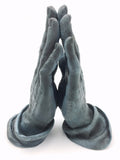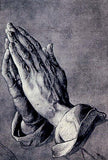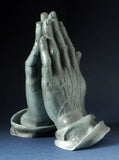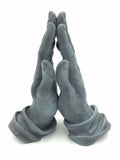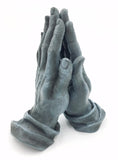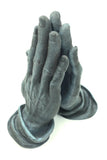In 1507, Durer was commissioned by the wealthy merchant, Jacob Heller, to paint a triptych for the altar of the Dominican church in Frankfurt, based on the theme of the ascension of Mary. The 'Heller altar' was soon so famous that Elector Maximilian of Bavaria had the central panel added to his own art collection. The panel was lost in a fire in 1729, but well over twenty preliminary sketches have been preserved. Of these, the 'praying hands of an apostle' is the most famous. The statue of Durer's Praying Hands is adapted from his sketch.
ALBRECHT DURER (1471-1529)
Graphic artist, painter and theoretician who formed an important link between Northern and Southern European art and who is regarded as the founder of German High Renaissance. As the son of a Nuremberg goldsmith, Durer had mastered all manner of art and craft techniques at an early age. When he was fifteen, he started a four year apprenticeship with the painter and graphic artist Michael Wolgemut who, at that time, had quite a reputation. He worked in Wolgemut's atelier on altar paintings, designs for stained-glass artists and woodcuts for illustrations in books.
In 1490, as was tradition, the young artist set out on a long journey. He stayed in Basel for a long time and carried out book illustration assignments and mastered the sophisticated techniques of copper engraving and etching. Four years later he returned home and married Agnes Fey. The marriage, which his father had arranged, was a childless one. He soon left, this time to avoid the plague, and headed for Italy. There he learned to compose, discovered the wonders of perspective and the use of colors by the thriving Italian renaissance painters. He became a personal friend of the Bellini brothers.
Upon Durer's return to the town of his birth he set up his own atelier and started selling his own engravings and etchings. Entirely in keeping with the Renaissance he was a keen student of science in his capacity of homo universalis and wrote theoretical essays on the arts. He moved in circles of progressive humanist scholars and was a leading citizen in the influential free imperial city of Nuremberg. Holy Roman Emperor Maximillian enlisted Durer into his service and paid him a substantial annual allowance.
Durer's last major trip took him to the Netherlands. Upon his return to Nuremberg he painted his most influential portraits and wrote theoretical works on the science of measurement, perspective and proportion. His death in 1528 marked the end of a very productive life during which he was acknowledged as the greatest German artist of his time. As a link between Northern and Southern Europe he was also the founder of the German High Renaissance.







